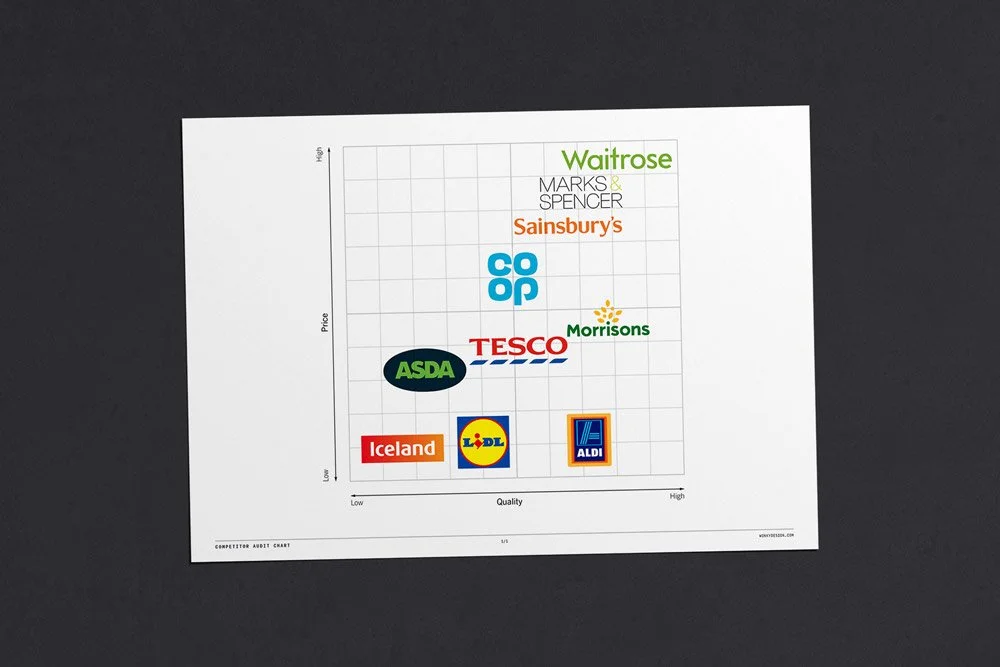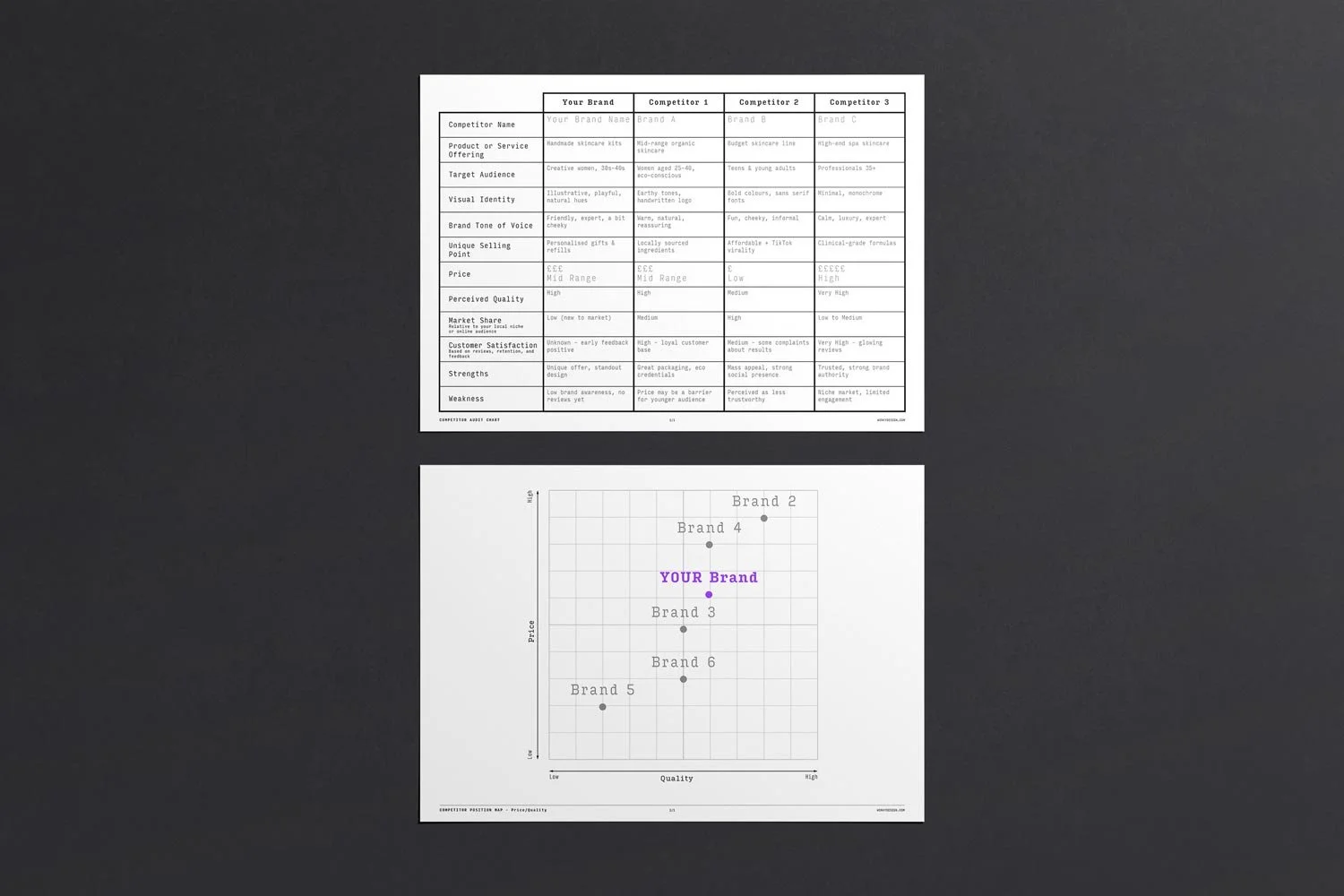Positioning Your Brand for Success: Finding Your Place in the Market
6min read
The secret to growing your business isn’t just a flashy logo or catchy slogan – it’s where your brand sits in customers’ minds. Brand positioning is all about carving out that sweet spot in the market where you stand out from rivals. As branding expert Marty Neumeier notes:
“DISTINCTIVENESS is the quality that causes a brand expression to stand out from competing messages. If it doesn’t stand out, the game is over”
In other words, if your small business blends in with the crowd, it won’t grab attention or loyalty. This post shows creative entrepreneurs how to pinpoint their unique position, with expert quotes, real UK examples and eye-opening stats to guide the way.
Why Brand Positioning Matters for SMEs
Your brand isn’t just a logo, it’s the feeling people have about your business. UK marketing consultant Ashley Friedlein sums it up perfectly:
“Brand is the sum total of how someone perceives a particular organization. Branding is about shaping that perception.”
Good positioning means telling a clear story about who you are, what you do and why it matters. When customers get what you stand for, they trust you.
81% of consumers say they need to trust a brand before even buying from it
and nearly half (46%) are more likely to purchase from brands they trust.
Finding your unique place – whether you’re top quality, eco-friendly, ultra-convenient, or community-focused – creates that trust and loyalty.
Without it, your message gets lost and you risk being “just another” option.
Step 1: Clarify Your Brand’s Identity
First, lock down the core of your brand. Ask:
Who are we?
What do we do better or differently?
Why does it matter to our audience?
These answers form your brand’s purpose and values. Write them down clearly – like a mini mission statement. This isn’t fluff; it’s your anchor. A clear internal foundation helps everything else fall into place.
For example, the London fintech Monzo knew its purpose early on: to revolutionise banking with transparency and community. That mission (and its distinctive hot coral card) helped Monzo leapfrog old banks. Monzo “challenged the traditional banking industry… by embracing transparency, consumer trust and community”, making them beloved by UK millennials.
Spend time on this step: define your promise to customers. Jason Hartman calls it “a promise of quality, consistency, competency, and reliability”.
Jot down your key attributes (e.g. “friendly”, “artisanal”, “tech-savvy”, “eco-conscious”). These will guide your messaging and style. Remember Marty Neumeier’s advice: your positioning relies on being distinct yet relevant.
Brainstorm what makes you bold or unexpected, but still a fit for your audience. Consistency matters: 68% of businesses report that consistent branding (tone, color, message) drives significant revenue growth. So once you pick your core identity, stick to it.
Step 2: Scout the Competition
Next, research who else is fighting for your customers’ attention. This is the competitor audit stage. List
direct competitors (same customers, same offerings)
and indirect competitors (similar customers, different offers).
Then compare them across factors like products, price, messaging, strengths and weaknesses. For example, chart each brand’s key features or values.
Sample competitor audit chart comparing your brand to rivals.
Tools help!
Use tables or spreadsheets to compare things like service quality, price range, marketing channels, and brand personality. A free Competitor Audit Template can guide you through this analysis, ensuring you cover all angles.
As the Marketing Centre found, many UK firms lack formal strategy: only 44% even automotive brands had a clear brand proposition. Crazy. Don’t be one of them!
Understanding competitors reveals gaps in the market (maybe no one is eco-friendly or ultra-premium, for instance). It also shows who’s doing what, so you can learn and differentiate. Even small brands or shops can outshine bigger rivals by digging in here.
Take notes on what others’ customers seem to love. Online reviews and social media are gold mines. And remember: competitor research isn’t just a one-time task. Periodic audits help you keep pace with a fast-changing market.
Step 3: Plot Your Position on a Map
Now it’s time to visualize where you fit.
A classic approach is the brand positioning map. Choose two attributes that matter to your market (e.g. price vs. quality, or traditional vs. innovative) and draw a 2D chart. Plot each competitor where they fall. Then pin your brand on the map where you want to be. This makes clear how crowded each space is and highlights your sweet spot.
Sample brand positioning map (aka perception map) – featuring UK supermarket positions
For instance, if rivals cluster in “high price / traditional” you might aim for “mid price / modern” to grab a niche. The map can also inform your look and tone. The act of mapping forces you to commit to an identity.
You can create a simple map by hand or use free tools online.
BrewDog (UK craft brewer)
Consider beer maker BrewDog (UK craft brewer) as inspiration.
BrewDog started as a garage project by two Scots who were tired of bland beer.
They plotted themselves opposite the stodgy big brewers – rebellious, intense, “punk” beers with wild names.
The result: BrewDog “aligned product and brand” around that rebel attitude, building a cult following. BrewDog’s success came from giving people a cause to join: a true ‘crusade’ to stand for something. That’s positioning with passion!
Using a map can reveal if you’re accidentally similar to someone else. (Hint: if two brands are on top of each other, rethink your brand’s focus.)
Once your spot is chosen, use it everywhere – your logo, website colour, tagline, even the channels you use. For example, Monzo’s coral colour and chatty online vibe visually reinforce their friendly fintech position.
Remember: five to seven consistent impressions are needed before a customer remembers a brand, so reinforce your position at every touchpoint.
Turning Insights into Action
By now you have ideas. Time to make them actionable. Distill your findings into a few clear statements: your target customer’s problem, your brand promise, and your unique selling point.
Write a one-sentence positioning statement:
For [insert audience], [your brand name] is the [insert category] that [benefit/difference] because [reason].
This exercise is like creating an instant elevator pitch for your brand.
Use vivid differentiation: Maybe you cater to a young, urban audience who need tech-savvy marketing (like Monzo did for Gen Zers). State that clearly.
Tell a story: Even micro-entrepreneurs can weave a narrative (e.g. “We started in Newbury with a passion for eco-tools to help locals shop sustainably.”). A story adds authenticity.
Be consistent: Keep your tone and visuals uniform. Over time, this repetition builds recognition. (Studies show consistent branding drives growth and that 94% of marketers stress personalised experiences help brands grow.)
Don’t do this alone: get feedback. Show your draft positioning to friends or customers and see if it makes sense. Adjust until it clicks.
And yes, download our free worksheets to guide you: a Competitor Audit Template (to catalogue rivals neatly) and a Brand Positioning Map worksheet (to sketch your market quadrant). These tools turn abstract strategy into concrete plans.
Ready to Stand Out? Your Next Steps
Brand positioning is an ongoing journey, not a one-off. But with clarity on your identity, competition, and niche, you’re well on your way. If you want a headstart, grab the free PDF worksheets mentioned above to audit competitors and map your positioning visually. These will help make your strategy concrete (and yes, they’re designed for easy printing or filling on screen).
Remember: The clearer and more distinct your position, the more your brand will shine amidst the crowd. Keep it true, keep it consistent, and watch your small business grow.
Ready to make your mark? Your audience is waiting for a brand worth shouting about!















